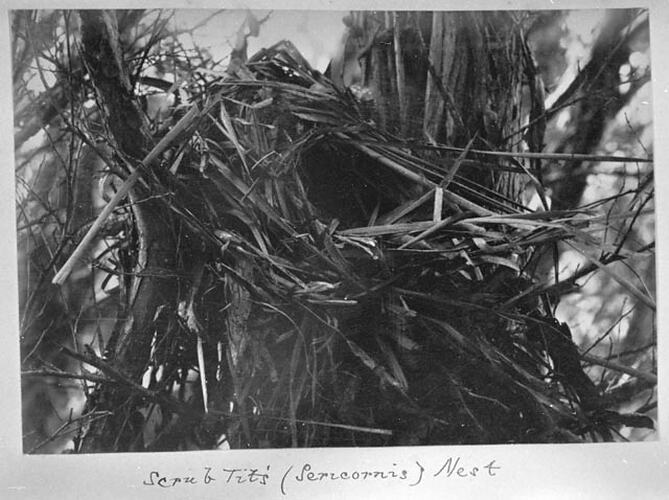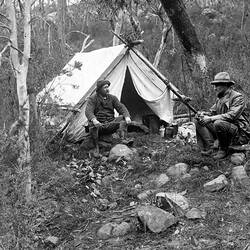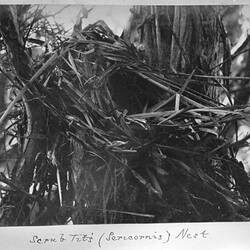WHITE BROWED SCRUB WREN (Sericornis frontalis, Vigors and Horsfield - 197)
Geographical Distribution - Queensland, New South Wales, Victoria, South Australia, and Kent Group (Bass Strait)
Nest - Bulky, roundish in shape, with side entrance; somewhat loosely constructed of grass, moss, bark, and dead leaves and fronds; lined inside with fine grass and feathers. Usually placed near the ground in thick scrub or in debris. Dimensions, outward diameter, 5 or 6 inches; entrance, about 1 inch across.
Eggs - Clutch, three; swollen oval in shape; texture of shell fine; surface glossy; colour varies from warmish or buffy-white to light purplish-buff, splashed and streaked with short marks of purplish-brown, sometimes chestnut, thickest on the apex, where they coalesce in the form of a zone. Dimensions in inches of a proper clutch: (1) .85 x .62, (2) .84 x .64, (3) .84 x .63.
Observations - The White-fronted, or more descriptive still, the White-browed, Scrub Hen, is a common species, enjoying a habitat throughout the whole length of Eastern Australia.
According to the 'British Museum Catalogue' Gould's smaller bird, S. minimus, is merely a northern variety of S. frontalis, and shows very distinctly the white eye-stripes. The question of variation of sub-specific differences in birds is very perplexing to ornithological students. There is another and insular variety of the White-browed Scrub Hen, which was first found during the expedition of the Field Naturalists' Club of Victoria to Kent Group, in 1890, for which Colonel Legge has proposed the sub-specific name gularis, (Victorian Naturalist, vol. xiii, p. 84, 1896) on account of its marked difference (darker) on the throat. It has also a conspicuously larger bill, and there are other minor points which serve to distinguish it from the mainland variety.
The White-browed Scrub Wren and the White-naped Honeyeater (Melithreptus lunulatus) were two mainland species of birds, which we found on Kent Group, that are not found in Tasmania.
There are various conjectures as to how the birds first came there. Their progenitors may have been carried to their insular quarters (about forty-five miles from the mainland) by the north-west gales that occasionally prevail. This agency may likewise account for the presence of the European Sparrow on Kent Group, which undoubtedly came from Victoria.
Another cause may be the visitation of great forest fires in Gippsland, such as occurred in 1897-8. Indeed, Captain Simpson, of the steamer 'Thermopylae', did report on that occasion, that when off the Gippsland coast line it was completely obscured, and as immense volumes of smoke curled up from the fires and were blown seawards by a strong land breeze, thousands of insects and hundreds of birds were carried from their haunts far out to sea, numbers alighting on the rigging and decks of the steamer.
I have procured White-browed Scrub Hens from the Big Scrub of New South Wales, and have taken many of their nests artfully hidden away in scrub or forest debris in many localities in Victoria, notably in the coastal thickets of tea-tree (Leptospermum), where these birds may be said to be plentiful and breed early, some commencing to lay in August. In the season of 1888 I took three nests with each three eggs, on the 6th August. The following year, in September, I noticed five or six freshly-built nests, and one containing thee fresh eggs.
Mr. C.F. Belcher reports that at the end of July, 1893, he took six nests, with eggs, of a Sericornis, in the Polygonum scrub, Lake Connewarre. I did not see a skin, but I believe the bird to be referable to this species. Some of the nests were on the ground, others were placed in tea-tree (Melaleuca), at a height varying from seven to eleven feet above ground.
Although this Scrub Wren usually builds low, I also recollect taking a nest with eggs, ten or twelve feet from the ground, or rather above water, near the tops of some melaleuca, on Phillip Island, Western Port, and October, 1880.
Breeding months are July to November or December.
Regarding the White-Browed Scrub Wren, and from knowledge gained through a correspondent in the Heytesbury Forest, Mr. Robert Hall states:- 'Before any sign of a nest was shown, a Sericornis placed a few grasses together in a thick-leafed bush, and continued to increase the mass for thirty minutes, when it discontinued, and gave vent to a number of grating notes to make up for lost vocal time, and appealed to its mate who had been hopping about branches close by watching the operation, for a recognition of its work. This was at 11 a.m., and it then adjourned work till 6 a.m. the following morning, when one hour's work was given to the nest. during the whole of which time a series of peculiar grating calls was given off, and nothing more was done until the same hour of the third morning 18th September, 1896), when the roomy cell of homogeneous plant-matter received the addition of an inner wall of another grassy material (mainly old withered leaves). The bird now made an alteration in its time table, and during the fourth, fifth, and sixth mornings, laboured from about an hour before noon to an hour after, working leisurely throughout the time until the lining was completed. On the seventh day the first egg was laid; colour brownish-purple spots and short streaks on a ground of lighter similar shades. The second egg was deposited on the ninth day of the month, and the third egg on the eleventh. On the fourteenth the bird had set itself to the task of incubation.
'In regular visits to four nests the eggs were found to be laid each forenoon early; the young birds hatched out on the twenty-third day from the time of laying third egg, and the young were able to fly on the fifteenth day from the breaking of the shell. The family immediately begins a nomadic life, and the locality is left to other birds before the morning of the following day. During the time of incubation the sitting bird leaves the nest to feed at early morning and evening, and at night returns with a small feather or some downy plumage, so that gradually the internal layer of its house is completed to it is satisfaction.
'In six nests observed in that district, two were lined with fur of rabbits, the others with feathers; all were inclined, with entrance protected from above, and all faced the north-east, which is the fine weather quarter at that period of the year. It was noticeable that the intelligence of the birds led them to build the external portion of their dome nest during rain or in early morning, when the wiry grasses are pliable, and the wet-softened material could be more easily adjusted to the required shape, while the inner layer was constructed at mid-day, when the material was drier.'
Illustrations of two nests of the White-browed Scrub Wren are given.
Resources
Transcribed Archibald James Campbell. Nests and Eggs of Australian Birds, including the Geographical Distribution of the Species and Popular Observations Thereon, Pawson & Brailsford, Sheffield, England, 1900, pp. 245-247.
More Information
-
Keywords
-
Authors
-
Contributors
-
Article types


